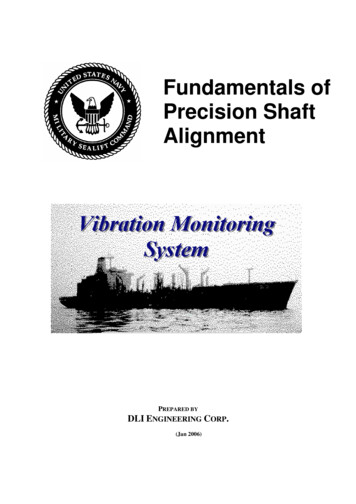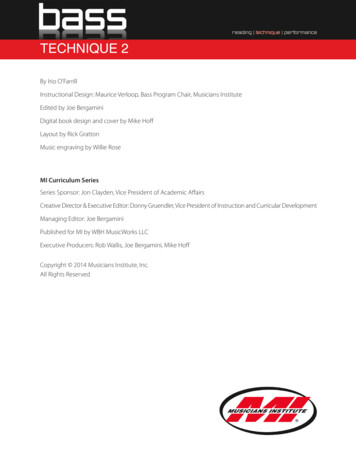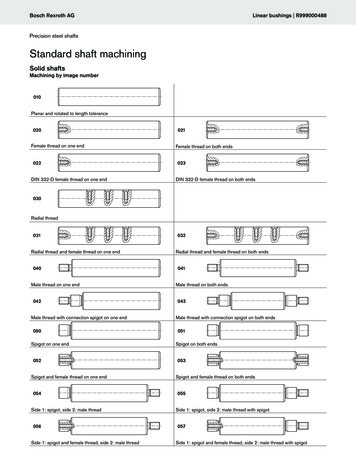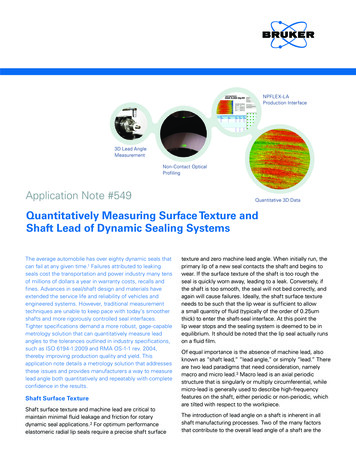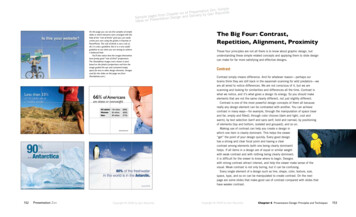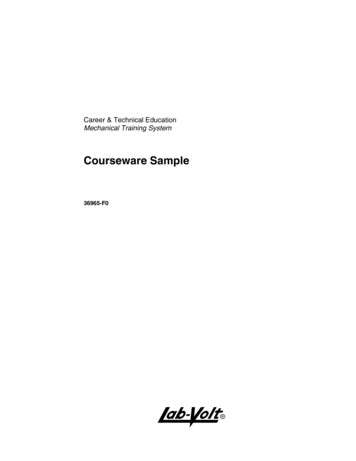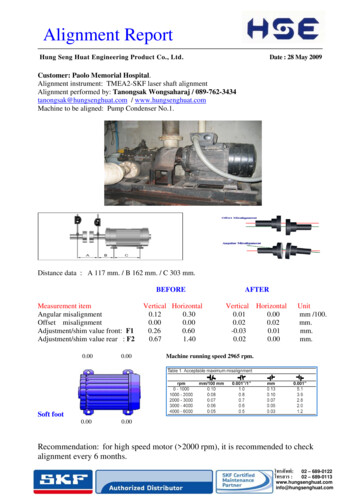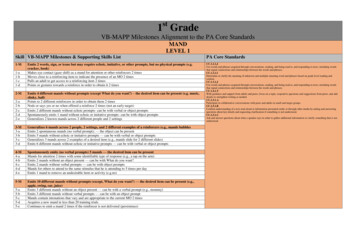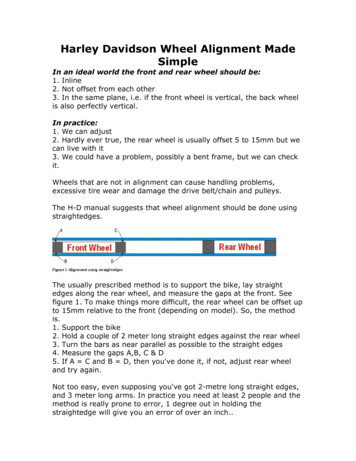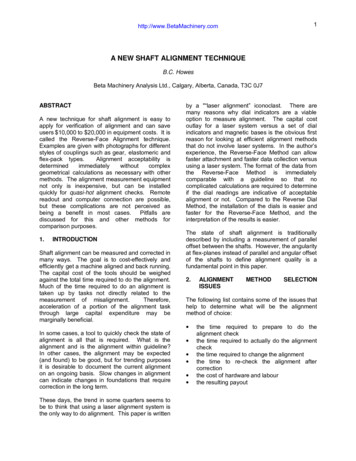
Transcription
1http://www.BetaMachinery.comA NEW SHAFT ALIGNMENT TECHNIQUEB.C. HowesBeta Machinery Analysis Ltd., Calgary, Alberta, Canada, T3C 0J7ABSTRACTA new technique for shaft alignment is easy toapply for verification of alignment and can saveusers 10,000 to 20,000 in equipment costs. It iscalled the Reverse-Face Alignment technique.Examples are given with photographs for differentstyles of couplings such as gear, elastomeric andflex-pack types.Alignment acceptability isdeterminedimmediatelywithoutcomplexgeometrical calculations as necessary with othermethods. The alignment measurement equipmentnot only is inexpensive, but can be installedquickly for quasi-hot alignment checks. Remotereadout and computer connection are possible,but these complications are not perceived asbeing a benefit in most cases.Pitfalls arediscussed for this and other methods forcomparison purposes.1.INTRODUCTIONShaft alignment can be measured and corrected inmany ways. The goal is to cost-effectively andefficiently get a machine aligned and back running.The capital cost of the tools should be weighedagainst the total time required to do the alignment.Much of the time required to do an alignment istaken up by tasks not directly related to themeasurement of misalignment.Therefore,acceleration of a portion of the alignment taskthrough large capital expenditure may bemarginally beneficial.In some cases, a tool to quickly check the state ofalignment is all that is required. What is thealignment and is the alignment within guideline?In other cases, the alignment may be expected(and found) to be good, but for trending purposesit is desirable to document the current alignmenton an ongoing basis. Slow changes in alignmentcan indicate changes in foundations that requirecorrection in the long term.These days, the trend in some quarters seems tobe to think that using a laser alignment system isthe only way to do alignment. This paper is writtenby a "“laser alignment” iconoclast. There aremany reasons why dial indicators are a viableoption to measure alignment. The capital costoutlay for a laser system versus a set of dialindicators and magnetic bases is the obvious firstreason for looking at efficient alignment methodsthat do not involve laser systems. In the author’sexperience, the Reverse-Face Method can allowfaster attachment and faster data collection versususing a laser system. The format of the data fromthe Reverse-Face Method is immediatelycomparable with a guideline so that nocomplicated calculations are required to determineif the dial readings are indicative of acceptablealignment or not. Compared to the Reverse DialMethod, the installation of the dials is easier andfaster for the Reverse-Face Method, and theinterpretation of the results is easier.The state of shaft alignment is traditionallydescribed by including a measurement of paralleloffset between the shafts. However, the angularityat flex-planes instead of parallel and angular offsetof the shafts to define alignment quality is afundamental point in this paper.2.ALIGNMENTISSUESMETHODSELECTIONThe following list contains some of the issues thathelp to determine what will be the alignmentmethod of choice: the time required to prepare to do thealignment check the time required to actually do the alignmentcheck the time required to change the alignment the time to re-check the alignment aftercorrection the cost of hardware and labour the resulting payout
http://www.BetaMachinery.com3.METHODS DISCUSSEDThe methods that will be referred to in this paperare: Reverse-Face Reverse-Rim (more familiarly called ReverseDial Method) Rim-Face, and LaserA good reference in the discussion of alignment isa book by John Piotrowski called “Shaft AlignmentHandbook” (Ref. 1).Piotrowski’s allowablemisalignment guidelines will be discussed with thisauthor'’ interpretation of how to apply theguidelines. Comments by Piotrowski, combinedwith a reference from another paper, about gearcouplings are included. There is no mention of theReverse-Face Method in Piotrowski’s book.4.THE GOAL OF ALIGNMENTThe goal of the alignment process is to make theangularity at each flex plane of the couplingsufficiently small with the machine in operation.This statement assumes a spool piece coupling. Ifthe coupling has a single flex-plane, then theoffset between the centerlines of the shafts at theflex-plane must be made sufficiently small, as wellas the angularity. Note the use of “sufficientlysmall” as opposed to “minimized”. In the case ofgear couplings or u-joints, it is not desirable toeliminate angularity totally, as discussed below.5.DESCRIPTION OF THE REVERSE-FACEMETHODThe dials indicators should be mounted in pairs,180 degrees apart, at each power transmissionpoint or flex-plane. The reason for this pairing isto compensate for axial float that can, and usuallydoes, occur during the rotation of the shafts.(There are those who use one face dial andattempt to force the shafts into the same axialposition for each reading. I do not recommendthis approach.)Refer to Photograph 1 for an example of how tomount a dial in the face direction across a flexplane.The dials should be labelled distinctively (eg: dialA1 and dial B1, dial A2 and dial B2). Start withdials A at 12:00 o’clock and B at 6:00. Record thereadings in pairs for dials A at 12:00, 3:00, 6:00,9:00 and 12:00. Convert the A&B readings into2float-compensated A readings (eg: A*1 and A*2)by the formula [(A-B)/2].There are two possible sign conventions for thedial readings. If the dial indicator base is mountedon one side of the flex-plane and the dial ispointing away from the magnetic base as ittouches the other side of the flex-plane, then apositive change in the dial reading indicates thecoupling halves are closing. This is the standardmounting convention. On the other hand, if thedial is turned around to point back toward the baseas it touches the other side of the flex-plane, thenthe sign convention is reversed: a positive changein the dial reading indicates the coupling halvesare opening.This is a potential source ofconfusion for the uninitiated. Photograph 1 showsa dial indicator in the standard orientation. (Dialindicators show a positive reading when theplunger is pushed in.)The diameter of the circle described by the dialsas the shaft is rotated is the basic dimensionrequired for calculating flex-plane angularity. Thelengths between flex-planes and the distancesfrom flex-planes to feet on the machine-to-bemoved, are also required before alignmentcorrections can be calculated.Turning the shaft to the usual 4 positions of theclock can be done by eye (often there are boltpatterns that help), or an inclinometer can beattached to the shaft for more precise guidance asto shaft angular position.Data quality is checked by comparing the sum ofthe vertical dial readings with the sum of thehorizontal readings. Ideally, the sums should beequal. In practice, small differences will be seen.Repeat the collection procedure if the differencesare “large”. Large is to be considered relative tothe dial readings. If the misalignment is large,then a larger difference between horizontal andvertical dial sums can be accepted. The finalsums for normal machines are usually no morethan 1 or 2 thou different. Some alignmentmethods offer the option of not making a full turnon the dials or laser equivalent. This short-cutloses the data check discussed above.For discussion purposes, a viewpoint for themachines is required. View the unit from thedriven machine, looking toward the driver. Leftand right sides of the unit are determined this way.The flex-planes can be referred to as the near andfar, near being closest to the driven machine.
http://www.BetaMachinery.comUsually, the driver will be the machine to bemoved.The allowable angularity should be determined atthe start of the job if speed is of the essence. Thegraph in Figure 1, is recommended for thispurpose. The maximum shaft speed is requiredas well as the type of coupling. Gear couplingsshould be left below the bottom line. Convert thealignment guideline expressed in mils per inch intomils TIR by multiplying the guideline by thediameter swept by the dials. The result is thelargest difference that should be seen between thevertical or the horizontal dial readings [the axialfloat compensated readings of course.](Note: 1 mil 1 thou .001 inch)The measured flex-plane angularities in thevertical and horizontal planes are calculated bydividing the difference between the dial readingsby the dial swept diameter. A sample spreadsheetis included as an appendix.Alternatively,compare the dial reading differences with thenumber calculated from the guideline angularity.The ultimate check of angularity is done by takingthe square root of the sum of the squares of thehorizontal and vertical angularities at each flexplane. This is the correct way to determineangularity, but in most cases, will make only asmall difference.In all alignment work, the issue of hot versus coldalignment must be addressed. I have found that inmost cases, the Reverse-Face Method allows meto mount the magnetic bases and collect the dialdata within 5 minutes. In my experience, thermalchanges of consequence occur after about 10minutes. If hot alignment is more critical, [forexample, if pipe loads or shaft torque influence aresuspected to influence alignment], there are othermethods such as Vernier Alignment or EssingerBars that can be used. No method that requiresthe shutdown of the machine to check alignment issuitable, in the limit, for critical hot alignmentchecks.The calculation of the horizontal moves andvertical shim changes is based on simplegeometry.A spreadsheet is shown in theappendices that we use to do this calculation.6.REVERSE-FACEMETHODOTHER METHODSVERSUSLaser Systems cost significantly more than a setof dial indicators, lack a calculated angularity at3the flex-planes, and are noted for problems due tomisuse by users, in the author’s experience. Onthe other hand, the speed of data collection andcalculation of moves and shims is excellent. Insome cases, the brackets are too bulky to swing afull circle. Some systems get around this problemby calculating the missing readings from severalintermediate readings at known angles.The Reverse Dial or Reverse-Rim Methodrequires complicated brackets plus correction forbracket sag. The installation of the brackets takeslonger than mounting a set of face dials. Theresulting dial readings must be converted viacomplex calculations to angularity numbers. Thecost of the brackets is greater than the cost of facedial equipment. The speed of collection of data iscertainly no faster than the Reverse-Face Method.TheRim-FaceMethod has thesamedisadvantages as the Reverse-Rim Method forspool piece couplings.However, since it isinsufficient for alignment determination in generalto measure an angle across a single flex-planecoupling [in other words, the Reverse-FaceMethod does not work in this instance], one of theRim-Face Method, or the other methods above, isrequired when there is no spool piece. Rim-Faceis a logical method to complement the ReverseFace Method since no special brackets arerequired to use Rim-Face for a single flex-planecoupling. All that is required is three magneticbases and dials. In addition, for couplings like thatshown in Photograph 3, the Rim-Face Method isthe only logical method. Reverse-Rim or Lasercan be used, but the brackets would be a sight tobehold.7.LIMITATIONS OF THE REVERSE-FACEMETHODCare must be taken when using the Reverse-FaceMethod on gear couplings or elastomericcouplings that can develop radial clearance due towear. Refer to Photograph 2 for an example ofthese two types of coupling on one machine. Theradial clearance in the couplings must bemeasured. (This is not a hardship, since theclearance must be measured to monitor the wearin the coupling.) Then, the difference in the radialclearance between ends, must be used to correctthe angularities calculated normally, A calculationof the radial clearance-induced angularity at thecoupling flex planes can be done using simplegeometry [angle difference in the radialclearances/distance between flex-planes].
http://www.BetaMachinery.comThe other limitation, as discussed above, is thesingle flex-plane coupling, which requires the RimFace Method.8.OPPORTUNITIES FOR ENHANCEMENTSOF THE REVERSE-FACED METHODIf it is considered to improve the speed of datacollection, or to automate the method, there aremany things that could be done, as summarizedbelow: special dial indicators with integral magneticbases for specific coupling designs remote digital readout of dial indicators readings at 45 degree orientations, convertedto horizontal and vertical calculation on a spreadsheet with manual dataentry direct input to the computer using digital dialindicators addition of a digital inclinometer calculation of the angularities and correctionsbased on less than 360 degree rotation ofshafts calculation of shims at many planes combination of cold and hot alignment data tocalculate desired cold angularity error analysis calculation using tolerances ondial readings.The author has generated a spreadsheet tocalculate dial readings at orthogonal points [3:00,6:00, 9:00] from dial readings at other angularlocations.Again, this is a simple geometryexercise.9.GUIDELINES FORRELATED ISSUESALIGNMENTANDThe original impetus to use the Reverse-FaceMethod was to make it easier to determine if aparticular alignment was acceptable. Piotrowski’sgraph [see Figure 1] provides a strong argumentfor using angularity at each flex plane to determineacceptability.Gear couplings are a special case. The relativetooth velocity should be calculated to determine ifthe oil film will break down due to misalignment(maximum of 5 in/sec pk (Ref. 2)). On the otherhand, minimum angularity is also required toensure that the oil will get between the teeth.Many manufacturers and most Laser Alignmentsystems use gui
alignment or not. Compared to the Reverse Dial Method, the installation of the dials is easier and faster for the Reverse-Face Method, and the interpretation of the results is easier. The state of shaft alignment is traditionally described by including a measurement of parallel offset between the shafts. However, the angularity at flex-planes instead of parallel and angular offset of the .
